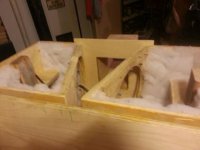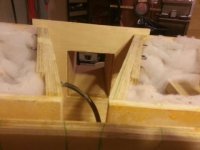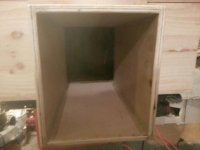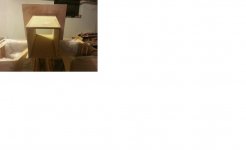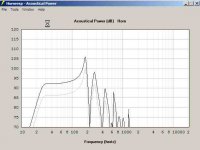That is great progress. Bracing sometimes takes longer to implement than main structure. You did a great job on the bracing - it should be fine now. Just button it up and you are done. That is one mean looking sub 😀
Hey lawabiding,
This thread might be of interest 🙂
http://www.diyaudio.com/forums/subwoofers/177905-thread-those-interested-ppsl-enclosures.html
This thread might be of interest 🙂
http://www.diyaudio.com/forums/subwoofers/177905-thread-those-interested-ppsl-enclosures.html
I think given two boxes of optimal volume, the Max SPL for slot loaded bandpass vs regular bass reflex will be the same. What you get with the slot loading 6th order bandpass is additional control of the cone motion by having fb at the excursion minima and natural falloff at higher frequenciws. Also, the duct is now semi directional so that you can sort of aim the output through a single duct, which, in your case, is critical to get the output from the trubk of the car to the main cabin.
Can't wait to see the in-car pics & measurements!
Regarding "the slot loading 6th order bandpass (BP6) is additional control of the cone motion by having fb at the excursion minima and natural falloff at higher frequencies," you should get increased power handling and SPL over a vented enclosure.
Regarding "the slot loading 6th order bandpass (BP6) is additional control of the cone motion by having fb at the excursion minima and natural falloff at higher frequencies," you should get increased power handling and SPL over a vented enclosure.
The drivers are dual voice coil right, if they are 4 ohms ea then you can wire them in parallel for 2ohms per driver and then wire the push pull in series for 4ohms total. Wire the one with the magnet facing out in reverse polarity. I am no expert on DVC drivers bit the simulations used the TS parameters given as 4ohms. I assume that is per split winding. I think you want to avoid wiring DVC coils in series as that changes the TS parameters (Re is doubled, Le is doubled, but I don't know what happens to the other params.
The drivers are dual voice coil right, if they are 4 ohms ea then you can wire them in parallel for 2ohms per driver and then wire the push pull in series for 4ohms total. Wire the one with the magnet facing out in reverse polarity. I am no expert on DVC drivers bit the simulations used the TS parameters given as 4ohms. I assume that is per split winding. I think you want to avoid wiring DVC coils in series as that changes the TS parameters (Re is doubled, Le is doubled, but I don't know what happens to the other params.
The drivers are dual 2ohm not dual 4ohm
Maybe Tb46 or someone else can help, but given that the drivers are dual 2ohm, wire them parallel per driver and series between drivers with reverse polarity on the one with the magnet sticking out. This should give overall 4ohms load. You can't get 8 ohms unless you wire all coils in series and I don't think that is advisable as it will mess up the T/S params with a very high Le and the Bl will be very different.
Hi guys,
Spend all day on the road. The weather was great.
The SWR-12D2 has its Re listed as 1.950+1.950. If you connect these two coils in parallel you get a 1 Ohm driver, if you connect them in series you get a 4 Ohm driver. The individual drivers then should be connected to arrive at the desired final amplifier load.
For 8 Ohm connect two 4 Ohm drivers in series (remember to turn one driver around).
If you connect 2ea. 4 Ohm in parallel you get 2 Ohm. You cannot get to 4 Ohm and use all 4 coils.
I would try all in series for 8 ohm for a single amplifier channel.
If you have multiple amplifier channels available you can set it up as 4 or 1 Ohm per speaker/channel.
Regards,
Spend all day on the road. The weather was great.
The SWR-12D2 has its Re listed as 1.950+1.950. If you connect these two coils in parallel you get a 1 Ohm driver, if you connect them in series you get a 4 Ohm driver. The individual drivers then should be connected to arrive at the desired final amplifier load.
For 8 Ohm connect two 4 Ohm drivers in series (remember to turn one driver around).
If you connect 2ea. 4 Ohm in parallel you get 2 Ohm. You cannot get to 4 Ohm and use all 4 coils.
I would try all in series for 8 ohm for a single amplifier channel.
If you have multiple amplifier channels available you can set it up as 4 or 1 Ohm per speaker/channel.
Regards,
Tb46,
Thanks for that - so no issues with the TS params changing from what is listed when connected in series for 4ohm? Doesn't that make the motor have double the Le and double the Bl(2x as strong) and Vas is now half? Maybe doesn't matter? I just don't want the performance to be degraded from the simulated design.
Thanks for that - so no issues with the TS params changing from what is listed when connected in series for 4ohm? Doesn't that make the motor have double the Le and double the Bl(2x as strong) and Vas is now half? Maybe doesn't matter? I just don't want the performance to be degraded from the simulated design.
Hi xrk971,
I think it would not be a problem. What does it look like in AkAbak? In Hornresp it does not matter, you get the usual offset because of increased input power if you go series v. parallel without adjusting the Eg, but Hornresp looks at it a bit differently. I'll attach my Hornresp simulation with the warning, that it is not going to be quite the same as your AkAbak simulation.
Happy Thanksgiving!
Regards,
I think it would not be a problem. What does it look like in AkAbak? In Hornresp it does not matter, you get the usual offset because of increased input power if you go series v. parallel without adjusting the Eg, but Hornresp looks at it a bit differently. I'll attach my Hornresp simulation with the warning, that it is not going to be quite the same as your AkAbak simulation.
Happy Thanksgiving!
Regards,
Attachments
I would try all in series for 8 ohm for a single amplifier channel.
As this is for car audio duty, it might be best to connect them for a 2 ohm load instead. Most car audio subwoofer amps are quite happy with a 2 ohm load.
So it is safe to have a 8 ohm load from the speakers to the amp.Hi xrk971,
I think it would not be a problem. What does it look like in AkAbak? In Hornresp it does not matter, you get the usual offset because of increased input power if you go series v. parallel without adjusting the Eg, but Hornresp looks at it a bit differently. I'll attach my Hornresp simulation with the warning, that it is not going to be quite the same as your AkAbak simulation.
Happy Thanksgiving!
Regards,
Xrk971 what is the total amount of wattage both speakers can used before running out of xmax.
Last edited:
8 is typically safe, it is when you go to 2 ohms that most amps cannot handle. Many car amps are fine though. Look at rating in your amp. The voltage at xmax is given in the last set of sims I did. I seem to remember it was something pretty high like 65volts for 2ohms total. But you need to run a high pass filter to be able to hit those high powers. Something like a miniDSP or automotive sub active crossover. At 8ohms you don't have to worry about hitting xmax as it would be in 100+volts.
Last edited:
8 is typically safe, it is when you go to 2 ohms that most amps cannot handle. Many car amps are fine though.
No car audio subwoofer amp I know about works best at 8 ohms. Typically you end up cutting the power output capability by almost half if you connect a load of that impedance to them. They're almost always designed to handle 4 and 2 ohm loads without any issues, with some even being fine with 1 ohm loads.
- Home
- Loudspeakers
- Subwoofers
- PP Slot Loaded Sub with Alpine SWR 12D2
